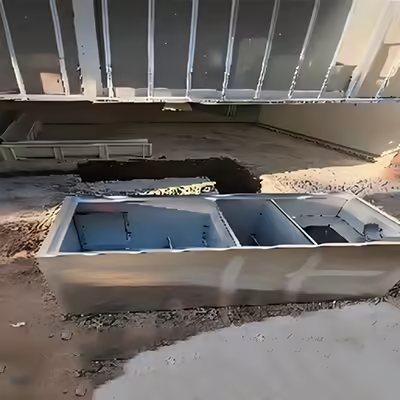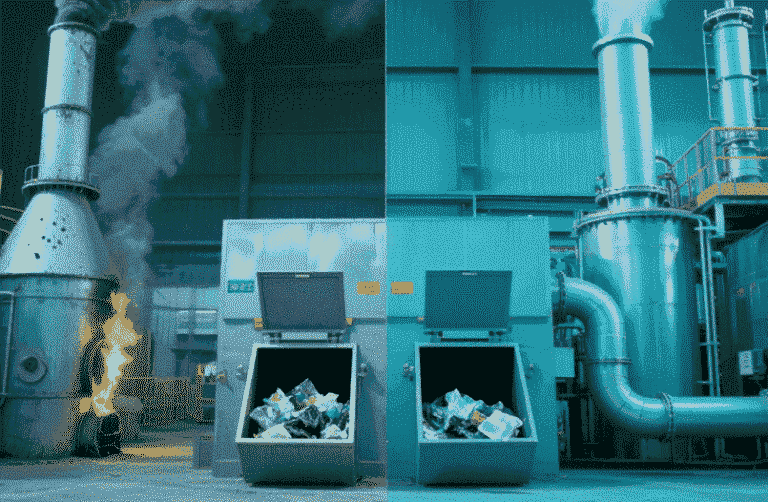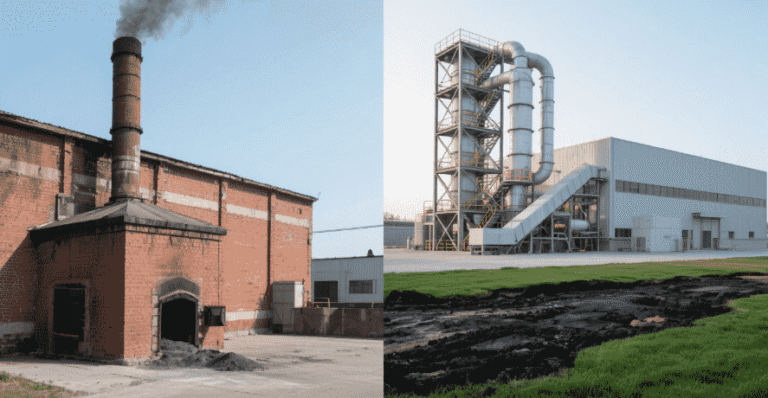Welcome to My Blog! 🌟
I’m so glad you’re here! Before we jump into the exciting content, I’d love for you to connect with me on my social media platforms. It’s where I share extra insights, interact with our amazing community, and post regular updates. Here’s how you can join the conversation:
📘 Facebook: Follow me on Facebook for more updates
Now, let’s dive into the journey ahead. I hope you find everything here both engaging and valuable. Together, let’s explore, learn, and grow! 🚀
Table of Contents
Small grease traps are compact plumbing devices installed at kitchen drains to capture fats, oils, and grease (FOG) before they enter the sewer system. A small grease trap comes in various forms – under-sink units, floor-mounted units, or even small in-ground interceptors – but all rely on similar principles of gravity separation. By slowing wastewater flow and providing time for grease and solids to separate, a small grease trap keeps kitchens cleaner and plumbing clear. In this in-depth article, we explain why a small grease trap is a smart investment. We cover four major benefit categories (operational, economic, environmental, hygienic), explain the technical workings of small grease trap systems (passive vs. automatic traps, sizing, separation), review global regulations and standards for small grease trap use, compare common small grease trap types, and answer frequently asked questions. All content is framed for restaurant owners, property managers, and homeowners considering a small grease trap installation.
Operational Benefits of Small Grease Traps

- Simple, reliable design: Most small grease traps are passive gravity-based units. Wastewater enters slowly, allowing heavier solids to settle and lighter grease to float to the surface. Because they have no moving parts or electronics, grease traps are inherently reliable and low-tech. They simply harness the natural density difference between water, food solids, and oils. This gravity-based operation means less can go wrong: no motors to fail, no power needed, and no complicated control systems. Even automatic (mechanical) grease traps – which use pumps or motors to flush out captured grease – must still meet the same gravity-separation requirements. In short, a small trap is a “set and forget” device in daily use, making kitchen operations more streamlined.
- Easy maintenance: Small grease traps typically have removable baffles or baskets for cleaning. Routine maintenance simply involves scooping or vacuuming out the accumulated grease and solids. Many models have convenient lid handles or even sight-glass indicators to show grease buildup. Since the volumes are small, cleanouts can be done quickly by in-house staff or by a service tech using a small vacuum truck or bucket pump. (By contrast, large external interceptors may require large vacuum trucks and excavation work.) The simplicity of design helps here too: there are no filters or membranes that can clog unexpectedly. In practice, a small grease trap in a modest kitchen often only needs cleaning every few weeks to months, depending on usage. This regular maintenance is straightforward and can even be scheduled around slow periods. Overall, the operational benefit is that the trap protects plumbing with minimal daily oversight; you only need to empty it periodically to keep it working effectively.
- Protects plumbing and equipment: By capturing grease at the source, small traps stop FOG and solids from entering drain lines and sewer mains. This prevents slow drains, backups, and emergency clogs that can disrupt kitchen service. For example, as the EPA notes, grease from restaurants (and homes) causes roughly 47% of reported sewer blockages. Each blockage can translate to costly downtime and repair. A small grease trap ensures that your sinks, drains, and sewer connection stay clear. This also protects downstream equipment such as septic systems or municipal wastewater plants. In short, having a trap saves headaches: instead of dealing with a fat-clogged pipe under your floor, you safely contain it in a removable trap.
- Versatility for many settings: Small grease traps come in different styles to suit various applications. Passive under-sink traps work well for single three-compartment sinks or food prep areas. Floor traps connect to floor drains or multiple sinks and are rated for higher flows (often 10–25 GPM or more). Automatic or “mechanical” grease traps (sometimes called grease removal devices, GRDs) can handle moderate flows (10–50 GPM) and are ideal where cleaning access is difficult — they self-wash by pumping grease to waste outside the trap. Even residential models exist; these look like small grease interceptors that attach under a home kitchen sink and handle a few GPM with plastic or stainless construction. This variety means that small traps can be tailored to each kitchen’s layout and output. They also integrate easily with existing plumbing fixtures. For example, one can install a small trap just on the sink waste line, while leaving other drains (mop sink, dishwashers, etc.) on separate lines if local code allows. The result is a customized solution that fits the space and usage of any establishment.
Economic Benefits of Small Grease Traps
- Cost avoidance (fines and repairs): Perhaps the biggest financial benefit of a small grease trap is what it prevents. Municipalities and utilities around the world often levy hefty fines on FOG pollution and blockages. In the UK, for instance, restaurants that ignored grease management have faced fines over £30,000. In fact, UK law makes it a criminal offense to discharge anything (including grease) that interferes with sewage flow. A small trap ensures compliance so you avoid penalties. Moreover, clearing a major grease-induced clog can be very expensive – emergency plumber calls, pipe replacement, even flooding damage. By contrast, a small trap cost (and maintenance) is modest. A one-time investment in a properly sized trap often pays for itself several times over by saving on these disaster-response costs. Local authorities report that poor grease control can lead not only to blockages but to floods, foul odors, pest infestations, and even forced business closures. Investing in a trap is a small price to pay compared to these risks.
- Lower installation and space costs: Small grease traps have a simpler installation than large concrete interceptors. An under-sink trap typically just connects with 2–4″ piping, and a floor trap can sit on a flat base without the need for deep excavation. This translates into lower labor and construction costs during setup. For a restaurant fit-out or retrofit, choosing a compact trap instead of a full-size underground tank can save thousands in installation expenses. Additionally, because the trap’s footprint is small, you don’t lose as much kitchen or utility space. For example, a 25 GPM floor trap might only occupy a 2×3 ft area on the floor, whereas a 1000 GPM interceptor could take a large yard area or building extension. Space is money in a commercial kitchen, so the leaner you can keep your grease management system, the better.
- Reduced maintenance expenses: In day-to-day operation, a small trap often costs less to maintain than a large interceptor. Scheduled cleanings for a trap can be as simple as taking out a bucket or using a small vacuum truck monthly. Contrast that with servicing a big tank, which might require heavy vacuum trucks, bypass pumps, and road closures. Even disposal costs are lower: a small trap might accumulate 20–50 lbs of grease between cleanings, whereas a large trap could fill 500+ lbs. Disposal services typically charge by volume/weight; capturing grease in smaller, more frequent batches can reduce the total hauled waste. Also, because small traps are easier to inspect and clean, problems can be caught early. For example, if a small trap starts to overflow, you can see and fix it before it leads to a sewer backup. In this way, maintenance is proactive and less expensive overall.
- Long-term asset value: A high-quality small grease trap is a durable asset. Many stainless steel traps are built to last decades, with corrosion-resistant construction. By contrast, repeated plumbing repairs and pipe snaking adds up over time. A one-time capital outlay on a trap also signals to regulators and inspectors that you take grease management seriously, which can protect your permit to operate. In the bigger picture, effective grease control helps your entire plumbing system run more efficiently for longer, reducing capital costs of premature replacements. While there is an upfront cost for a good trap, its economic “return” comes via years of uninterrupted kitchen service and avoided fines.
Environmental Benefits of Small Grease Traps
- Protects waterways and sewer systems: Keeping fats, oils, and grease out of the wastewater system has clear environmental payoffs. When grease enters sewers, it can congeal and cause sanitary sewer overflows (SSOs) or combined sewer overflows (CSOs), releasing untreated or partially treated wastewater into the environment. The EPA notes that grease is a leading cause of sewer blockages – roughly 47% of reported blockages are traced to grease from homes and restaurants. Those blockages in turn can drive sewage into streets or rivers, harming aquatic life and public health. By catching grease at the source, small traps help wastewater treatment plants operate more efficiently and reduce pollution events. In other words, every gallon of grease you trap is one less pollutant entering local waterways. Municipalities appreciate this upstream protection; many pretreatment programs specifically target FOG control as a key environmental goal.
- Enables resource recovery: Used cooking grease is not just waste—it can be a valuable resource if collected properly. Grease trap waste can be processed in various eco-friendly ways instead of going to landfill. For instance, anaerobic digesters can turn trap grease into biogas (methane) that is used for heating or electricity. The leftover solids (digestate) can become nutrient-rich fertilizer. In practice, some waste haulers take trap grease to bioenergy plants or composting facilities. One industry report notes that while fryer oil is often recycled into biodiesel, even grease trap contents can yield energy through anaerobic digestion or composting under controlled conditions. By installing a grease trap and using approved waste-disposal contractors, you keep grease in the loop of resource recovery. This contributes to reduced greenhouse gas emissions compared to letting grease degrade in a landfill or sewer (where it can produce methane uncontrolled).
- Reduces energy and chemical use: When grease is present in wastewater, treatment plants and lift stations often have to use more energy and chemicals. For example, more pump power is required to overcome grease-formed slicks, and additional sewer cleaning and jetting might be needed to maintain flow. Chemicals or enzymes might also be added to break down grease in pipes. Small traps decrease these secondary demands. In your own kitchen, preventing grease build-up means you won’t have to use harsh chemical drain cleaners or plungers as often. This saves on energy and chemical consumption, a small but meaningful environmental win especially when multiplied across many businesses.
- Supports sustainability goals: For eco-conscious businesses or homeowners, installing a grease trap is an easy step toward greener operations. It shows commitment to waste reduction and water protection. Some green building certifications and local regulations actually score or require FOG control measures. Additionally, many communities now recognize trap grease as a separate waste stream that can be handled responsibly. By segregating grease, you often can partner with waste companies that reuse it, unlike mixing grease into general wastewater. In summary, a small grease trap delivers environmental stewardship by preventing pollution at its source and turning a problem-waste into a potential bioresource.
Hygienic Benefits of Small Grease Traps
- Eliminates foul odors: Stagnant grease and food particles in drains can quickly produce rancid smells, detectable even outside the kitchen. A grease trap captures these smelly substances and confines them in a sealed unit, significantly reducing odor issues. Without a trap, warm drains often smell like rotten oils or decaying solids. With a trap, most odors stay in the container until it is serviced. Keeping grease and sludge out of living or dining spaces improves the overall cleanliness of the facility. In fact, hygiene regulations consider grease buildup a “nuisance.” In the UK, the Environmental Protection Act 1990 explicitly addresses “statutory nuisances” like smells from waste. A properly maintained trap prevents grease from accumulating in the drain plumbing, thereby minimizing any unsanitary odors.
- Prevents pest problems: Grease and food remnants in drains attract flies, rodents, and other pests looking for a food source. By trapping these substances before they enter the sewer, you break that chain. Pest control becomes simpler because there are fewer food residues for pests to feed on inside floor drains and sewage vents. This is especially important for food service businesses that must avoid cross-contamination. A clean, grease-free drain system is less likely to harbor fly larvae or rodent nests in plumbing lines. Together with routine trap cleaning, this makes the kitchen a less inviting environment for pests. Good grease trap hygiene often correlates with better scores during health inspections.
- Compliance with health regulations: Many health and building codes tie grease control directly to sanitation standards. For instance, the UK Food Safety Act 1990 gives authorities the power to inspect kitchens and shut down operations if sanitation is poor. Problems “arising from poor grease management” can trigger enforcement or prosecution under these food safety laws. Similarly, US foodservice guidelines warn that blocked or unsanitary drains violate sanitary codes. In this sense, a small grease trap is a proactive health measure. It ensures that wastewater is handled properly, which in turn maintains a sanitary environment. By capturing FOG at the source, traps keep the dishwashing area and plumbing cleaner, which helps in passing health inspections and keeping staff safe.
- Maintains clean equipment and surfaces: Grease that escapes into the kitchen via drains can end up coating floor drains, basement sumps, or even appliances. Over time, this leads to slippery floors, greasy buildup in remote drain lines, and discolored walls or ceilings in cellars (when grease vapors condense). A small grease trap avoids these issues by intercepting grease early. Staff won’t have to scrub their feet before exiting the sink area or clean slimy buildup around floor drains. This contributes to a cleaner workplace overall. Additionally, appliances like dishwashers or garbage disposals operate more efficiently when drains are clear. The trap protects them from carrying away chunks of oil that could damage pumps or valves. Overall, hygiene improves when grease is systematically removed instead of scattered through the kitchen plumbing.
How Small Grease Traps Work

Small grease traps operate on simple but effective principles. Understanding these will help you choose and use the right trap.
- Gravity separation (passive traps): Most small traps are gravity-based. The incoming wastewater is slowed down and kept in a chamber. Over a short “retention time” (typically 15–30 minutes), heavier solids settle to the bottom and lighter fats/oils rise to the top. Middle layer water (relatively free of grease) exits through an outlet pipe. Inside, baffle plates or weirs often help keep the flow calm and prevent disturbance of settled grease. No electricity or moving parts are needed – this is purely passive physics. The effectiveness depends on having enough volume (calculated from flow and retention requirements) and a cool enough temperature (hot water can carry more grease in suspension). For example, European standards (EN 1825) require enough trap volume so that wastewater remains in the separator long enough for 95% of grease to float out. In practice, this means sizing the trap slightly above your peak sink flow and cleaning it regularly. The longer the wastewater sits in the trap, the more complete the separation.
- Automatic (active) grease traps: In high-volume or hard-to-access locations, “automatic” grease traps (also called Grease Removal Devices, GRDs) are an option. These use internal pumps or mechanisms to periodically remove the collected grease. However, even automatic traps must still have a gravity-based core. The automatic part typically just moves grease from the top of the trap to a waste container or drains it to a holding tank, so the trap doesn’t need manual cleanout as often. Plumbing codes often define an automated trap as one “designed to remove grease using mechanisms that do not rely on gravity” (meaning it actively pumps grease out). In a small GRD, sensors detect when grease reaches a certain level and then trigger a purge cycle. This benefits busy kitchens by extending the interval between manual cleanings. However, these units are more complex and expensive than passive traps. Some jurisdictions require special permits or approvals for GRDs because of their moving parts. Overall, they are best for situations where regular manual cleaning is difficult or disruptive (for example, when trap access is cramped or cleaning schedules are infrequent).
- Key separation principles: The basic science behind all grease traps is density difference. Water is denser than vegetable oil (0.92–0.97 g/cm³), and both are denser than air. In a trap, oil droplets coalesce and rise because they are lighter than water. Food solids (egg shells, bones, coffee grounds) typically sink because they are denser. Some traps include a “solids basket” at the inlet to catch big particles. Temperature matters too: cool water helps grease congeal and float. Very hot water (over ~140°F) can hold grease in suspension longer, which is why many installers recommend not pouring scalding water directly into the trap. Instead, moderate temperatures or pre-cooling help separation. Some systems even use a small baffle or chamber where water is diverted to cool before entering the main trap.
- Flow control and sizing: Properly sizing the trap is essential. A trap is rated by its flow capacity (GPM or L/s) and grease storage (often in pounds or kilograms). Typical small traps range from a few GPM (1–5) up to about 50 GPM. Local codes vary, but a common rule-of-thumb (from the Plumbing & Drainage Institute’s standards) is that trap capacity (in pounds of grease) should be roughly twice the peak flow rate. For example, a 10 GPM trap is often rated for 20 lbs of grease. Under many plumbing codes, traps must provide a retention time (often 30 minutes) at peak flow. This means the volume (in gallons) = flow rate (GPM) × 30. For instance, if your sink flow is 20 GPM, you need at least 600 gallons of trap volume (which would be a very large trap). In practice, small traps use combination rules that account for intermittent usage and multiple fixtures. Plumbing codes provide sizing tables or formulas: measure sink compartment sizes in cubic inches, convert to GPM (1 cubic inch = 0.00433 gallons), adjust for usable capacity, and apply a drainage period factor. The key is always to size to handle your peak drain event without forcing grease into the sewer. Too-small traps quickly overflow and fail. Many local authorities allow only certain trap sizes or follow standards like ASME A112.14.3 (hydromechanical interceptors) which correspond to PDI G101 sizing. We recommend consulting a professional or using a trap-sizing calculator to pick the right unit.
- Installation tips: A few best practices help a trap work well. Install the trap as close as possible to the fixture it serves (shorter pipe runs mean less opportunity for grease to solidify in between). Ensure the inlet pipe slopes down toward the trap (minimum 2% slope) and has a straight run of pipe (e.g. 10× pipe diameter length) before it to quieten flow. The outlet should be lower than the inlet to avoid re-suspending grease. All trap connections should use the manufacturer-supplied flow-control fitting: this prevents surges of water that could flush grease through. As [15] describes, the inlet must have a non-adjustable flow restrictor so the trap never sees flow above its rating. Traps must also be readily accessible – you’ll need to open them for cleaning. Some small traps have removable covers or screwcaps for this reason. If a trap is outdoors or in a cold area, insulate or heat-trace it because freezing water can break the unit. With these details right, a small grease trap will function effectively.
Regulatory Standards for Small Grease Traps

Whether you’re a homeowner or business operator, it’s essential to know the rules. Many regions mandate grease traps for food-related facilities, and they set standards on design and disposal. Below is an overview of key regulations globally:
- United States: The US Clean Water Act’s National Pretreatment Program requires control of pollutants like grease in sewer discharges. Federal regulations (40 CFR 403.5(b)(3)) explicitly prohibit “solid or viscous pollutants in amounts which will cause obstruction” in sewers. In practice, this means discharging untreated kitchen grease is illegal. Enforcement is delegated to local sewer authorities and health departments. Most US jurisdictions require food establishments to install grease traps or interceptors sized per plumbing codes. The Uniform Plumbing Code (UPC) and International Plumbing Code (IPC) reference ASME A112.14.3 for hydromechanical grease interceptors and PDI G101 standards. For example, many codes mandate a minimum grease trap flow rating of 20 GPM for commercial sinks (see discussion above). Some city codes add details: one municipal specification defines a grease trap as conforming to ASME A112.14.3 with 2″ connections and minimum 20 GPM/40-lb rating. Additionally, automated traps (per ASME A112.14.4) often need special approval. It’s common for US restaurants to be inspected for grease compliance. Areas like New York City even require written FOG management plans and contracts with licensed haulers to pump out traps. Overall, while there is no single federal “small trap” law, local codes usually enforce the EPA’s pretreatment philosophy.
- Europe (EU/UK): In the European Union and UK, the main standard is BS EN 1825 (parts 1 & 2). EN 1825-1:2004 sets design, performance, and marking requirements for grease separators with flows ≥1 L/s (which is about 16 GPM). EN 1825-2:2002 covers sizing and operation. Even small separators must comply if used for commercial purposes. EN 1825 requires a maximum effluent grease content (25 mg/L), meaning the trap must be efficient. In the UK specifically, Building Regulations (Part H, 2002 edition) mandate that drainage for commercial kitchens include a compliant grease separator. UK law (Water Industry Act 1991, Section 111) also makes it a criminal offense to discharge anything that could clog sewers. Enforcement by water companies is strict: grease traps must be UKCA (formerly CE) marked and meet EN 1825 requirements. In many EU countries, similar local plumbing codes or environmental permits demand grease traps for any building serving hot food. Generally, BS EN 1825 is the only harmonized standard covering grease traps in Europe.
- United Kingdom: Beyond the EU rules above, the UK has specific guidance. Building Regs Part H specifically mention grease separators for commercial kitchens. The Water Industry Act makes discharging grease into public sewers an offense. The UK Environment Agency provides best-practice guides: these note that improper grease disposal can violate the Environmental Protection Act 1990 (creating a “statutory nuisance” by smell). Local water companies increasingly issue FOG compliance notices; refusal to cooperate can lead to large fines or orders to install traps. In fact, some councils fined businesses £30,000+ for non-compliance. The takeaway is clear: in the UK, having an EN 1825-certified trap isn’t optional for a restaurant – it’s a legal requirement. Even small premises like cafes or mobile food units may need under-sink grease traps to comply.
- Australia and New Zealand: Both countries treat grease as a regulated wastewater pollutant. In Australia, the national standard AS 1546.2 (on-site sewage treatment) includes grease traps, but more often local water authorities enforce their own requirements. The standard AS 4494 (“Discharge of commercial liquid waste to sewer”) gives water agencies the power to regulate grease trap design and use. This means requirements can vary by state or council. However, many agencies have adopted European sizing or performance criteria. For instance, Australian manufacturer ACO notes that local rules are inconsistent, so they design traps to meet EN 1825 benchmarks. In short, Australians typically need “grease arrestors” sized for their kitchen flows, and authorities inspect and fine for failures. Similarly in New Zealand, local council guidelines mandate a “suitably sized grease trap” on commercial kitchens. The NZ guidelines explicitly require traps to cool and separate fats/grease and solids. They also warn that traps must be regularly cleaned to keep material from entering treatment systems. Both countries treat FOG as an “approved trade waste” discharge, requiring permits and consistent maintenance.
- Other Regions (e.g. Singapore, Hong Kong, etc.): Many Asian cities have strict FOG laws. For example, Singapore’s Sewerage and Drainage Act makes grease traps compulsory for food businesses, with regular inspections and record-keeping required. Hong Kong’s Water Pollution Control Ordinance similarly regulates FOG. While specifics differ, the international theme is consistent: capturing grease is often mandated for any establishment cooking on premises. For homeowners with private septic systems, local regulations may also require small grease traps or restrict FOG disposal. Always check your municipal or utility guidelines before installing.
In summary: Grease traps are not just a nice-to-have; they are often a legal necessity. Internationally, standards like EN 1825 (EU), ASME/PDI (USA), and local plumbing codes set the technical bar, while environmental laws (Clean Water Act, Water Industry Act, etc.) give regulators teeth to enforce grease capture. A small grease trap installed to these standards will help you stay compliant, avoid fines and sanctions, and protect the public sewer system.
Comparison of Grease Trap Types and Capacities
| Grease Trap Type | Flow Capacity (GPM) | Grease Storage (lbs) | Material / Construction | Typical Use / Notes |
|---|---|---|---|---|
| Under-sink trap | ~1–10 GPM (few LPM) | ~5–20 lbs (2–9 kg) | Plastic or stainless steel, compact box under sink | Small kitchens, cafes, home use; manual clean-out. Limited flow suits single sink or low-volume prep areas. |
| Floor-mounted trap | ~10–25 GPM (40–100 LPM) | ~25–100 lbs (11–45 kg) | Stainless steel or durable plastic bowl | Standard restaurant use (sink banks, floor drains). Usually rated in a series (e.g. 10, 15, 25, 40 GPM). Installed on floor. |
| Automated (GRD) | ~10–50 GPM (40–190 LPM) | ~20–80 lbs (9–36 kg) | Stainless steel with pump/motors | Busy commercial kitchens. Pumps trapped grease to waste tank automatically. Reduces manual cleaning frequency. |
| In-ground interceptor | ~50–500+ GPM (190–1900+ LPM) | 100–500+ lbs (45–227+ kg) | Precast concrete or large polyethylene tank | Large volume kitchens (hotels, hospitals). Installed underground outside. Must be pumped out regularly by service companies. |
Each trap type above has trade-offs. Under-sink units are the most compact but handle the least flow (and grease). Floor traps and GRDs serve mid-size operations; GRDs cost more but auto-clean. In-ground interceptors handle huge flows but are outside the “small” category – they require digging and heavy maintenance. When choosing, match your kitchen’s peak flow (sum of sink flows) to the trap’s flow rating, and ensure the grease capacity matches expected waste. All traps should conform to recognized standards (e.g. ASME A112.14.3/G101 or EN 1825) for performance.
FAQ
Q: How often should a small grease trap be cleaned?
A: Cleaning frequency depends on usage. A busy restaurant might need weekly or monthly cleanouts, while a small cafe may only need quarterly servicing. As a rule, a small grease trap should be cleaned whenever the grease layer reaches about 25% of the trap’s depth or when solids accumulate significantly. Most small grease trap manufacturers recommend emptying at least every 2–4 weeks in commercial use. Regular inspection is key: if you notice slow drains or odors, that’s a sign the small grease trap needs cleaning sooner. Note that almost all municipal codes require keeping the small grease trap functional – letting it overflow is a violation. Keeping a simple log of small grease trap cleanings also helps demonstrate compliance.
Q: What’s the difference between a grease trap and an interceptor?
A: The terms are sometimes used interchangeably, but traditionally: a grease trap often refers to a small grease trap, such as an under-sink or in-building unit (generally up to 50 GPM). An interceptor usually means a larger, outdoor concrete or plastic tank (50+ GPM) installed below grade. Both systems work on the same principle of gravity separation, but interceptors have much greater capacity and retention time. In essence, a small grease trap is a type of grease interceptor designed specifically for low-flow conditions. For homes and small businesses, a small grease trap is typically sufficient. Large-scale commercial operations use interceptors.
Q: Can I use enzyme or bacteria additives in my grease trap?
A: Generally, adding enzyme or bacteria products to a small grease trap is not recommended and often explicitly prohibited. Most plumbing codes and small grease trap manufacturers advise against the use of chemical or biological additives because these substances can emulsify fats and oils, allowing them to pass through the small grease trap without separation. For instance, certain regulatory bodies ban any additive systems in small grease traps that include enzymes or microbes. The most reliable approach is mechanical removal—pumping or scooping out accumulated grease. If you are considering any additives, always check with your local plumbing authority first, as many codes mandate that small grease traps must function using gravity separation alone.
Q: Can I connect my dishwasher or garbage disposal to a small grease trap?
A: Dishwashers typically discharge very hot, so many codes disallow routing them through a grease trap (because the heat can melt fats and push them out of the trap). Garbage disposals are generally prohibited from draining into a grease trap (they overload it with solids). Instead, assign sinks with disposals to a separate drain (or even a separate grease trap sized for the disposal flow). As one set of specs notes, “Garbage disposals/grinders shall not be plumbed to a grease trap” for this reason. Floor drains and mop sinks usually go through traps (they collect fats on floors). Always follow local plumbing guidance: some areas allow disposals if the trap is sized extra-large, but many do not.
Q: Do I need a grease trap in my home kitchen?
A: Typically, residential kitchens do not use a grease trap unless they connect to a septic system. For septic users, a small under-sink grease trap can extend septic life by preventing fats from clogging the tank and leaching field. If your home is on municipal sewer, a grease trap is rarely required by law. However, a home owner might still use a small trap (often called a “garbage trap”) as a precaution if they frequently cook with oils. It’s a low-maintenance device that just gives you peace of mind. But for most homeowners on city sewer, the code usually only mandates a grease trap if the kitchen is part of a home-based food business (like a catering service). Check your local building code.
Q: How do I dispose of grease trap waste?
A: Grease trap waste is considered industrial waste. You cannot simply dump it down another drain or throw it in the trash. In most places, you must hire a licensed grease hauler or sanitary sewer company to pump out the trap and dispose of its contents properly (usually at a rendering plant or bioenergy facility). Keep records of each pump-out; some jurisdictions require them for inspection. This waste can often be recycled as mentioned earlier, so reputable haulers will pump it to a location where it’s processed into biogas or other products. While it may seem like an added expense, professional disposal prevents environmental violations. Some municipalities even offer grease hauler services to businesses.
Q: What happens if the grease trap overflows?
A: Overflowing a grease trap is a serious problem. It means untreated sewage mixed with FOG is escaping downstream, which can lead to sewer blockages or contamination. If you observe an overflow (grease or sewage coming up out of a drain), immediately stop using the kitchen drain and call a plumber. You will need to clean the trap and likely flush the line. Additionally, notify your waste authority if required. Repeated overflows can result in fines or orders to upgrade your trap. Prevention is best: monitor the trap level (some units have indicators) and maintain a regular cleaning schedule to avoid overflow situations.
Q: How do I size a small grease trap correctly?
A: A simple sizing method for a small grease trap is to calculate the peak drainage flow of all kitchen fixtures that will discharge into the unit. For example, measure each sink’s volume (in cubic inches), convert to gallons per minute (by dividing by 231), and estimate how quickly the water drains—typically assuming full discharge within 1–2 minutes. If multiple sinks are involved, add their flow rates together. The chosen small grease trap should have a flow rating equal to or slightly above this combined peak flow. Additionally, the grease holding capacity of the small grease trap, often measured in pounds, is typically twice the GPM rating (e.g., 20 GPM corresponds to a 40-lb trap). It’s best to round up to the nearest standard model. Always consult the manufacturer’s sizing charts or relevant municipal code requirements. Undersizing a small grease trap may lead to inefficient separation and frequent maintenance. For optimal performance, ensure the small grease trap provides adequate retention time—commonly 20–30 minutes during peak flow conditions. When in doubt, consult a qualified plumber experienced in small grease trap sizing.
Q: What materials are grease traps made of, and which is best?
A: A small grease trap is most commonly constructed from stainless steel or high-strength polyethylene plastic. Stainless steel small grease traps (often 304 or 316 grade) are known for their corrosion resistance and durability, making them suitable for commercial kitchens dealing with high temperatures and regular cleaning. Polyethylene plastic small grease traps are lighter, generally more affordable, and immune to rust, though they may be more vulnerable to cracking in cold conditions or when exposed to certain chemicals. For under-sink or indoor installations, a stainless steel small grease trap is generally preferred due to its long service life and resistance to damage. Outdoor or in-ground small grease trap applications may use concrete or high-density polyethylene. No matter the material, ensure the small grease trap is certified by recognized organizations like NSF, ASME, or local plumbing authorities to meet safety and performance standards. Choosing the right material helps maximize your small grease trap’s operational reliability and lifespan.
Q: Are there any special maintenance tips for small grease traps?
A: Yes, maintaining a small grease trap properly is essential for long-term functionality and compliance. First, scrape food waste and solid residues from dishes into the trash before rinsing; this significantly reduces the burden on your small grease trap. Installing a sink strainer helps prevent solid debris from entering the trap. If your small grease trap includes a flow restrictor, make sure it’s functioning properly to avoid overwhelming the unit with a sudden surge of hot water or grease. When servicing the small grease trap, open the cover slowly to release any accumulated gases safely. Fully remove all waste—both surface grease and settled solids—and rinse the inside with a mild detergent. Inspect the lid seal and fittings to ensure there are no leaks. Never treat the small grease trap as a waste disposal bin: avoid pouring large amounts of oil, food scraps, or prohibited chemicals inside. Most importantly, don’t use enzyme or bacterial additives unless explicitly allowed by code, as these can disrupt grease separation. Maintain a written log of each small grease trap cleaning, noting the date, waste volume removed, and any abnormalities. Proper care ensures that your small grease trap continues to protect your drainage system and complies with health regulations.
Sources: This article draws on regulatory guidelines and expert industry information. For example, UK regulations (Building Regs Part H) require grease separators in commercial kitchensepas-ltd.com, and EPA studies show grease causes nearly half of sewer blockageswww3.epa.gov. International standards like EN 1825 (EU) define trap design and capacitycdn.ymaws.comacopassavant.com.au, and New Zealand guidelines emphasize trap sizing and cleaning for all commercial kitchensgdc.govt.nzgdc.govt.nz. Industry sources and product data confirm common flow and grease capacities (e.g., 20 lb traps at 10 GPMregencyequipment.com). All advice here is consistent with authoritative codes (ASME, PDI, NSF) and best practices for grease management.






